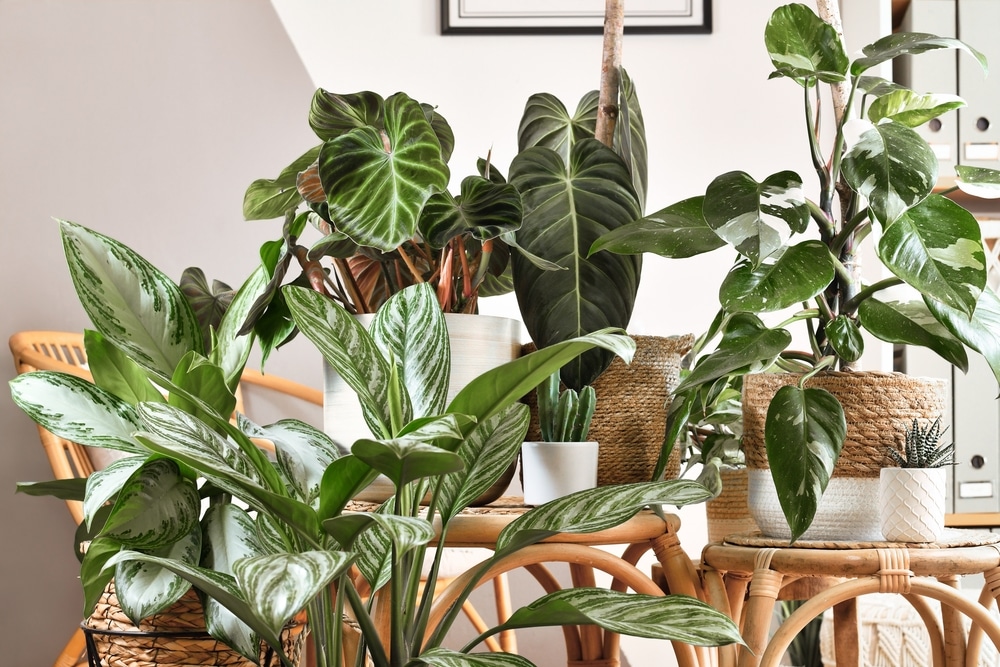Philodendrons are some of the easiest houseplants to care for and maintain. We’ve probably all seen a philodendron plant – even if we didn’t know that’s what it was called – at the office, in a school staff room, or in the doctor’s waiting room.
With a few exceptions, they can tolerate some neglect, so they’re perfect for beginners or to add some life to an office workspace where plants tend to get forgotten. Philodendrons can grow in low-light conditions but will grow fuller and faster with bright light.
There are literally hundreds of species of philodendron. Some are common and easy to find, while others are more rare and unusual.
In this article, I’ll take you through the different types of philodendrons, give some tips on how to grow and care for them, and feature my top 17 varieties to help you choose the perfect one for your home!
Types Of Philodendrons

Philodendrons fall into two main categories. First there are those that trail, and grow long vine-like stems. Then there are the bushier upright varieties that grow on sturdier stalks.
Vining & Trailing Varieties
In their natural habitat, trailing philodendrons in the rainforest grow up onto tree trunks, anchoring themselves with aerial roots as they climb. They can also be trained to grow upright on vertical supports such as trellises or moss poles.
Upright & Self-Heading Varieties
Upright philodendron varieties grow their leaves on long/tall petioles (leaf stem) from a central stem, rather than along trailing vines. This gives them a bushier tree-like look, which is why this group is also sometimes referred to as the “arborescent” (meaning tree-like) varieties.
The name “self-heading” refers to the way the older leaves at the base of the stem eventually die off, revealing more and more of the base of the main stem as the plant matures.
How To Grow Philodendrons
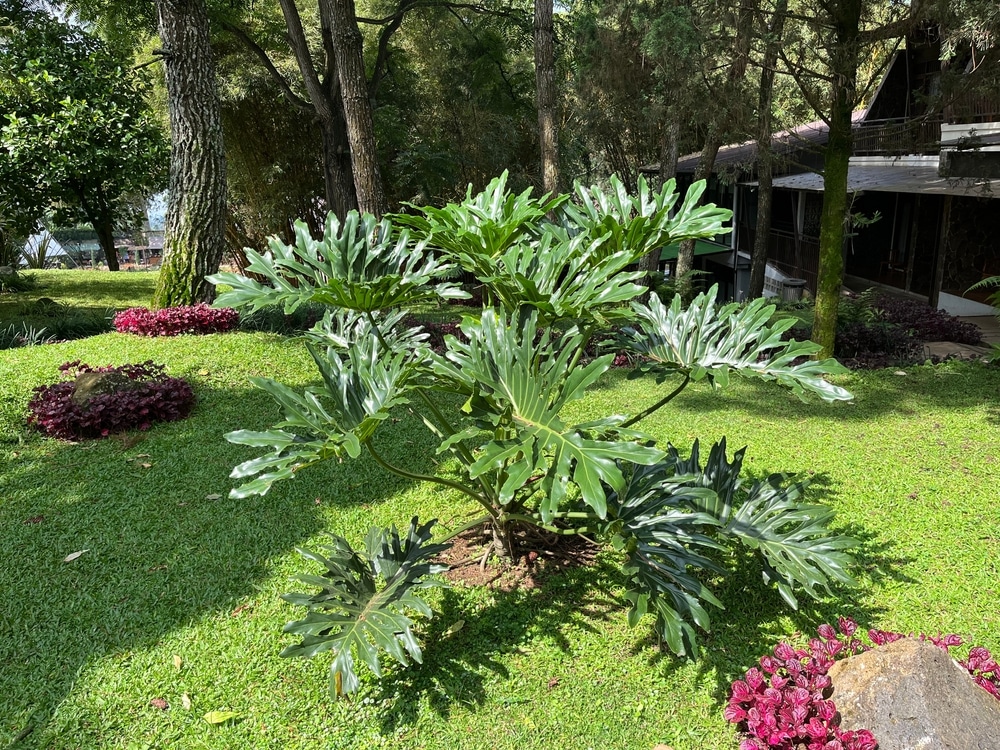
In their native habitat of tropical rainforests, philodendrons grow as understory plants, beneath the shading canopy of large trees. They receive dappled sunlight, and no direct sun for any length of time.
To imitate these conditions when growing philodendrons as houseplants in your home or office, give them bright but indirect sunlight. A north or east-facing window would be a good spot, or several feet back from a south-facing window.
They also prefer warm humid conditions, although some varieties can tolerate dry indoor air. Many varieties have large glossy leaves that benefit from the occasional dusting with a damp cloth.
Certain philodendrons have special needs but most share the following care requirements:
| Light | Bright indirect light. Some can tolerate low light but growth will be less vigorous |
| Potting soil | Well-draining and moisture-retaining. A blend of peat, perlite, and orchid bark |
| Watering | Use tepid or room temperature water, not cold. Consistent moisture but avoid over-watering. Allow the top few inches (centimeters) of soil to dry out between waterings, then water deeply |
| Fertilizer | Apply balanced liquid fertilizer (diluted according to instructions on the label) every two weeks during the growing season (spring and summer). Don’t fertilize in winter |
| Humidity | High humidity |
| Temperature | Ideally between 65 and 85 F (18 – 29 C) |
What Do Philodendron Aerial Roots Look Like?
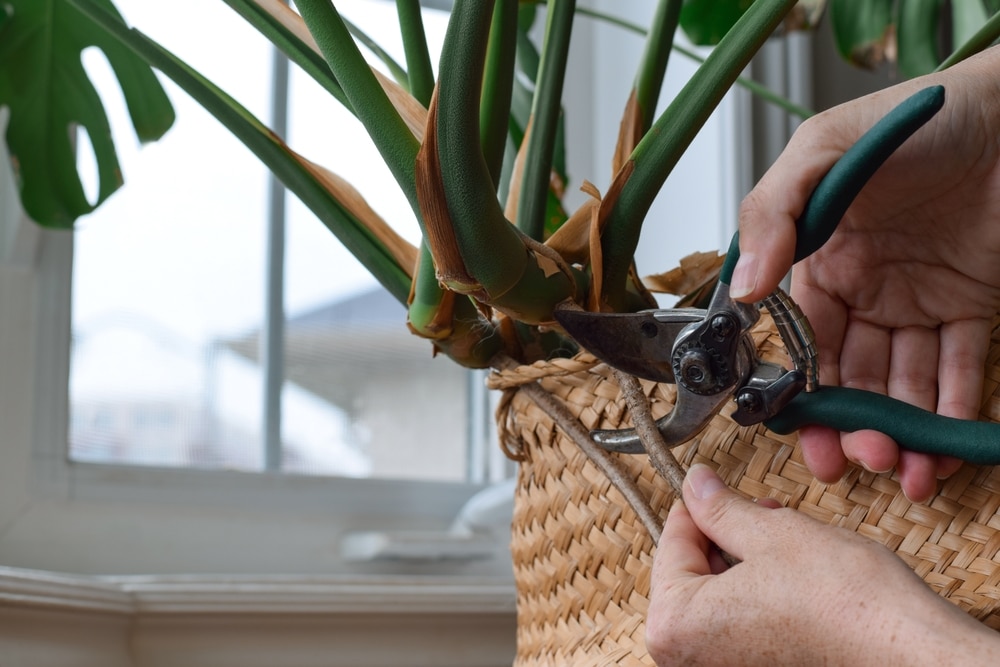
Most varieties of philodendron will eventually grow “aerial roots.” These roots grow from leaf nodes along the stem of the plant into the air rather than in the soil. They serve multiple purposes:
- To provide support to upright varieties
- To anchor climbing varieties to tree trunks in the rainforest
- To take up moisture from the air and nutrients from the soil once they reach the ground
Upright varieties grow aerial roots to support themselves as they grow taller. The roots grow outwards and down towards the soil, looking like multiple tree stakes. Once in the soil, they behave like soil roots, taking up nutrients and moisture to the plant.
The aerial roots on trailing philodendrons (and the climbing upright varieties) are used by the plant to attach itself to tree trunks – or to a moss pole if you provide one for your climbers.
Aerial roots on philodendrons look like long stiff rolled out pieces of grayish brown plasticine! There is no need to prune them off the plant; they are providing additional sources of moisture to the plant.
On trailing varieties grown on a moss pole, these roots should initially be tied to the pole to encourage them to grow into the moss.
If your upright philodendron grows aerials roots towards the base, you can bury their tips in the potting soil – if they don’t find their way there on their own.
If you don’t like the look of the aerial roots – they can sometimes give the plant a tangled appearance – you can prune them off with sharp pruners close to the main stem where they appear.
Training Climbing Philodendrons To Grow Vertically
For longer trailers, you can also purchase a moss pole (or make your own) to support the plant’s growth.
A moss pole is a tall pillar several inches thick made of moss wrapped around a sturdy stake and then wrapped in wire. It simulates a tree that a philodendron would grow on in its native habitat. The moss is kept moist with regular misting, so the plant’s aerial roots grow into it to anchor the vine as it grows. The moist moss also adds humidity to the air around the plant.
Moss poles are generally used for larger plants that sit in a pot on the floor. But you could also try a smaller version for a plant sitting on a side table.
Philodendron Care
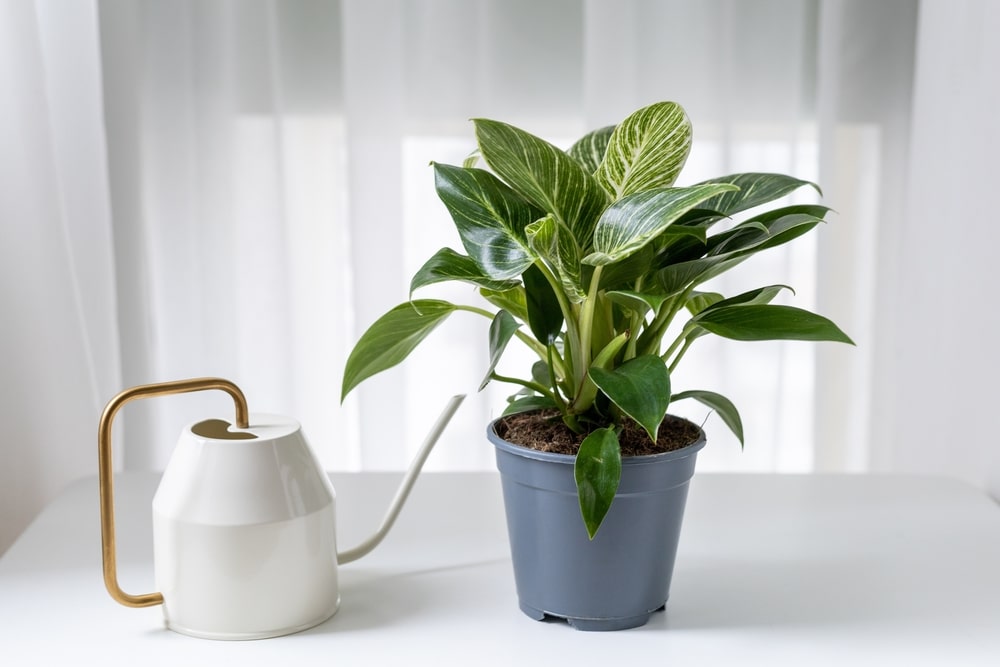
Houseplants of all sorts suffer from common challenges. Some are caused by environmental conditions (e.g. dry air, low light, too much water, not enough nutrients), others are the result of insect pests or disease.
Common Problems & How To Solve Them
Here are some of the most common issues you might encounter with philodendrons and how to address them.
| Sign | Problem | Solution |
|---|---|---|
| Droopy-looking leaves | Too much waterToo little water | For most plants, water when top 1 inch (2.5 centimeters) is dry |
| Leaves with brown tips | Too dryToo much fertilizer | Use a spray bottle to mist plantReduce feeding. Mix half the concentration and use it twice as often |
| Yellow leaves | Watering issueNot enough light | Water when top 1 inch (2.5 centimeters) is dryRelocate to a position of bright indirect sunlight |
| Bottom leaves yellow | Lack of Nitrogen (N) | Apply a houseplant fertilizer to provide some nitrogen |
| Yellow leaves on one side | Too much sun | Relocate plant out of direct sunlight |
Common Pests Of Philodendrons
Philodendrons are generally pest-free but they can sometimes suffer the same pests as other houseplants. Check your plants for signs of insect pests every time you water. Early detection and treatment means better success in eliminating the pest before it gets out of control.
| Problem | Signs and Symptoms | Solution |
|---|---|---|
| Spider Mites | Leaves turn speckled yellow (like spray paint), dry up and curl. Fine webs are visible on underside of leaves and on growth tips. Tiny mites are barely visible crawling on underside of leaves and in webbing | Wipe down all leaves with damp cloth. For severe cases, apply a commercial insecticidal soap product. Spray undersides of leaves and wherever there are webs.To prevent infestations, maintain high humidity around plants. |
| Aphids | New shoots and young leaves curl & turn yellow. Leaves may be covered with sticky coating.Aphids will cluster on new growth tips | For mild cases, wipe plant . Repeat every few days. For heavy infestations, prune off plant tips. Apply a commercial insecticidal soap product, spraying directly onto aphids. |
| Mealybugs | Leaves curl and turn yellow. Cotton-like white tufts are visible on underside of leaves and at leaf nodes on the stems | Using a cotton swab dipped in rubbing alcohol, carefully dab the clusters of insects. Apply a commercial insecticidal soap product. Spray directly on fluffy clusters. |
| White fly | Tiny white moth-like flies flutter around when plant is disturbed.Mottled yellow leaves with distorted growth. Sticky honeydew on foliage. | Hang yellow sticky-trap cards (one or two cards per plant) around infested plants at first sign of white flies to trap adults. Apply a commercial insecticidal product listed for white fly. Flies must be sprayed directly to be effective and repeat applications are usually necessary |
| Soft brown scale | Young leaves are pale and stunted. Scales are found on stems and along the centre vein on the underside of leaves.Black sooty mold may appear on leaves | Wipe scale off leaves and stems using a cotton swab dipped in rubbing alcohol. |
| Soil Gnats | Don’t pose a problem for plant health but can be a nuisance flying around plants | Allow top two inches (5 cm) of soil to dry out between waterings. Cover the soil surface with a half-inch (2 cm) layer of coarse sand or kitty litter |
Aesthetic Home Arrangements

Both the trailing and upright varieties can add beautiful color and visual interest to home decor or workplace spaces.
Some of the better known varieties, such as the Heartleaf philodendron, are trailing with heart-shaped leaves. Others, like the Philodendron ‘Xanadu,’ are stunning upright plants with deeply divided leaves. Their leaf-colors range from dark to bright green, pink, maroon, silver, and variegated options.
In addition to adding color and visual interest to home decor or the office setting, they all share the capacity to improve the indoor air quality. Philodendrons act like natural air filters to clear the air of chemicals such as formaldehyde and benzene.
Style Tips
Here’s some tips for styling the different types:
Hanging Displays: Trailing varieties, like the Heartleaf or Silverleaf Philodendron, can be grown in a hanging basket. Or try placing a pot on top of a bookcase to let the vines cascade down and enhance a room’s decor.
Add Height: They can also be tied to a trellis or other upright structure in a pot on a side table or countertop. This is a great option for adding height to your greenery in a small space.
Small Space: The Burle Marx doesn’t grow as tall as some of the other climbers or upright varieties, making it a good choice for smaller spaces.
Statement Piece: The glossy deeply-cut leaves of Xanadu give both texture and architectural interest to a space. It makes a showy statement in big open spaces where its tropical effect can be appreciated.
Table-Top: Consider using upright varieties as table-top specimens for the home or office when young.
Desk Companion: Smaller varieties are great for the office and have the added benefit of purifying the air, helping you focus more! Birkin is a smaller and slow-growing variety, so it works well on a desktop. It can also tolerate low-light conditions.
Corner Piece: In their taller mature form, upright varieties make great statement pieces in large pots on the floor. The Split-Leaf variety is a perfect choice for this aesthetic. These mature specimens make great statement pieces in open spaces such as home entryways, the corner of a bedroom, or commercial reception areas.
Tropical: Consider the Ecuador philodendron if you are looking to add a nice tropical vibe to your home.
Splash of Color: Think the Lemon Lime Philodendron! Because of its bright coloration and easy-care requirements, it makes a popular choice for workplaces, schools, and the home.
Bathrooms: All philodendrons thrive in humid conditions which make them a perfect choice for bathroom plants.
Top 17 Philodendron Varieties
The following is my list of a selection of interesting philodendron varieties. I’ve included 7 trailing and 10 upright/climbing types. Use this guide to help you choose the perfect philodendron for your home or office!
Trailing Philodendrons
1 – Brandt’s Philodendron, Silverleaf Philodendron, Brandi Philodendron (Philodendron brandtianum)
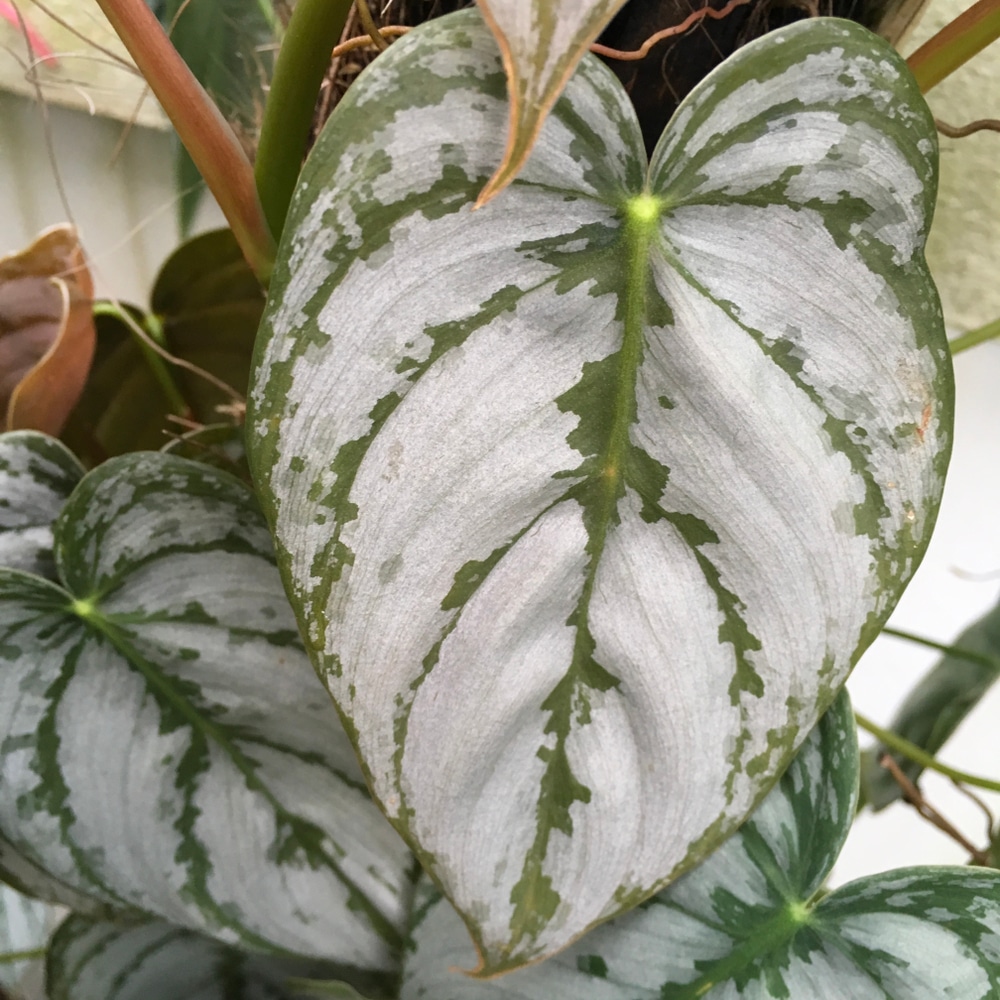
The silverleaf philodendron is a striking low-maintenance easy-care houseplant. It has large heart-shaped variegated leaves that are mostly silver-white with mottled olive-green along the veins. The leaves are glossy with a thick leathery texture.
With its trailing habit, it can be grown in a hanging basket or trained to grow on a moss pole support.
Despite their leathery texture, the leaves are sensitive to heavy moisture. Avoid getting them wet when watering the plant.
| Origin | Brazil |
| Plant size | 4-5 feet tall |
| Flowering | Rarely as a houseplant |
| Light | Bright indirect light |
| Watering | Allow top 2-3 inches (5 – 7.5 cm) of soil to dry out between waterings. Water deeply |
| Fertilizer | Apply liquid fertilizer, diluted to half the recommended strength, once a month during the growing season. Don’t fertilize in winter |
| Potting soil | All-purpose potting mix with additional perlite added for improved drainage |
| Pruning | Remove any dead leaves and stems. Prune to control size and encourage bushier growth |
| Repotting | Every 2-3 years, or when roots start showing from the pot drain holes |
2 – Heartleaf Philodendron (Philodendron hederaceum)
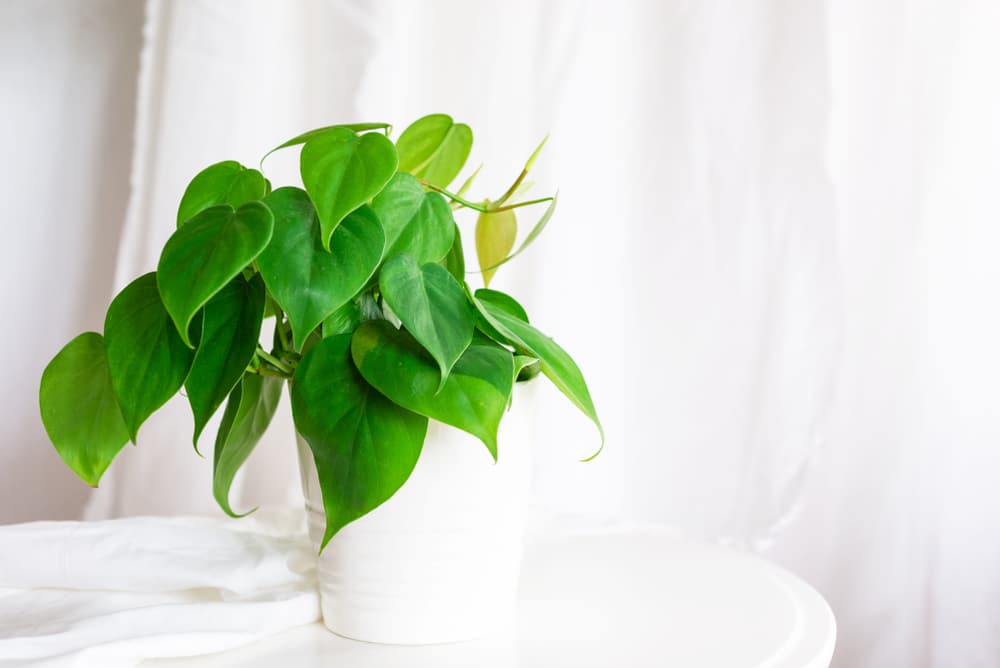
The heartleaf philodendrons are some of the easiest to grow and require little care. The glossy leaves are a fresh mid-green (not too dark, not too bright). When the leaves first grow in, they have a bronzy tinge that gradually fades to green as the leaves mature. The single leaves grow alternately along a trailing stem. It is considered a fairly slow-growing but long-lived plant.
They prefer bright indirect light but can survive in low light conditions. Grown in low light, however, the leaves may be smaller and further apart along the stem than plants grown with more light exposure. The plant may become “leggy”
The Heartleaf philodendron tolerates dry indoor conditions better than some other philodendron varieties.
| Origin | Tropical America |
| Plant size | 1-3 feet (30 – 90 cm) wide, trails 3 – 13 feet (90 – 396 cm) or more |
| Flowering | Rarely as a houseplant |
| Light | Bright indirect light. Tolerates low light |
| Watering | Allow soil to dry out between waterings, then water deeply |
| Fertilizer | Apply dilute water-in fertilizer once or twice during the growing season. Don’t apply in winter |
| Potting soil | All-purpose potting mix with extra perlite for good drainage |
| Pruning | Pinch back growing tips to encourage denser side growth |
| Repotting | Repot when plant becomes pot-bound |
3 – Brasil Philodendron (Philodendron hederaceum ‘Brasil’)
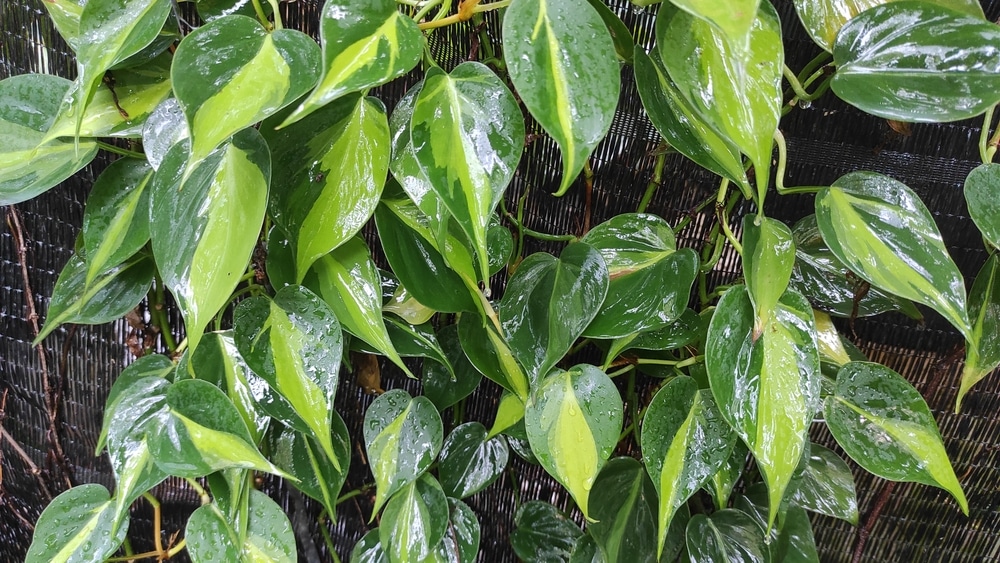
Brasil philodendron is a heart leaf cultivar, with beautiful yellow and lime-green stripes running down the center of its leaves. It is a fast-grower when given the right conditions. Giving it extra humidity indoors will encourage more vigorous growth.
It prefers bright indirect light but can grow in low-light conditions. If grown in low-light conditions, it may get leggy and lose its variegated coloring.
These philodendrons are not cold tolerant. Be sure to keep it away from cold winter drafts or summer air conditioners.
| Origin | Central America |
| Plant size | 4-6 feet (120 – 180 cm) tall, 1-6 feet (30 – 180 cm) wide |
| Flowering | Rarely as a houseplant |
| Light | Bright indirect light. Tolerates low light |
| Watering | Allow top 2-3 inches (5 – 7.5 cm) of soil to dry out between waterings, then water deeply |
| Fertilizer | Apply balanced liquid fertilizer every two weeks during the growing season |
| Potting soil | All-purpose potting mix with added perlite for drainage |
| Pruning | Prune in spring to control size and encourage bushy growth. Remove dead foliage |
| Repotting | Repot every 1-2 years when pot-bound |
4 – Lemon Lime Philodendron, Neon Philodendron (Philodendron hederaceum ‘Lemon-Lime’)
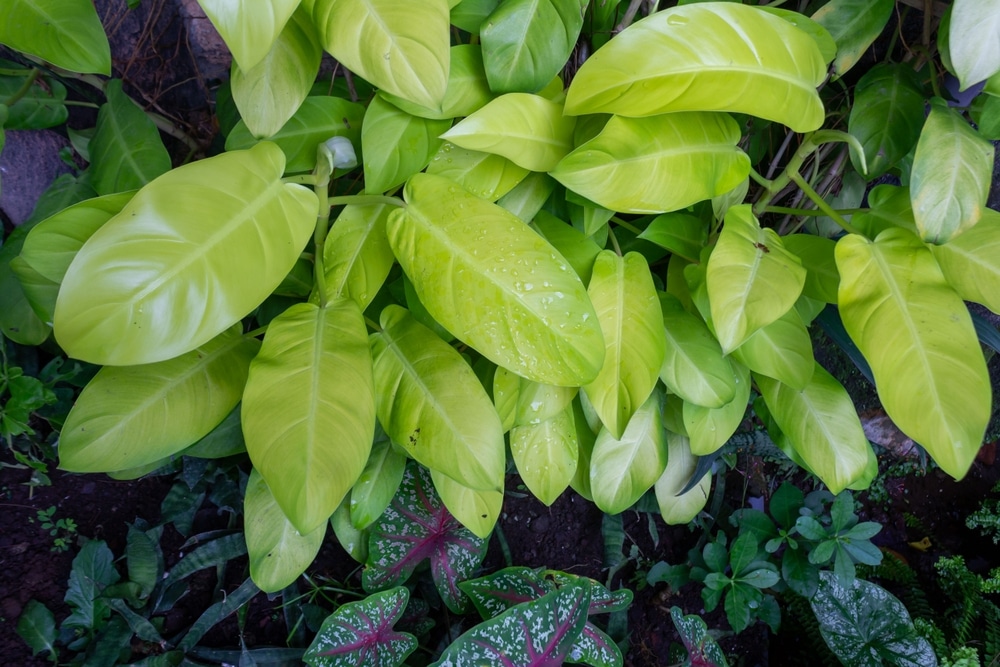
As the common names suggest, Lemon Lime philodendron has glowing bright yellow to chartreuse foliage. It has the classic heart-shaped leaves (but with an elongated tip) that grow alternately along a trailing stem. The leaves emerge a bright pinkish yellow, change to bright yellow then chartreuse green.
It can be grown as a trailer in hanging baskets or on the top of a set of tall shelves. It can also be trained on a support such as a trellis or moss pole to add vibrant vertical color to a space.
It can grow in varying light conditions, but if grown in low light, it won’t grow as vigorously. Its leaves will be smaller and spaced further apart along the vine (the plant will look “leggy”) and will lose their vibrant coloration.
| Origin | Central America |
| Plant size | Up to 12 feet (3.6 m) |
| Flowering | Non-flowering hybrid |
| Light | Bright indirect sun but tolerates lower light |
| Watering | Allow top half of soil to dry between waterings. Water thoroughly |
| Fertilizer | Use balanced fertilizer, diluted by half, once a month during growing season. Stop fertilizing in winter |
| Potting soil | Rich well-draining peat-based mix, with additional perlite for good drainage |
| Pruning | Pinch back growing tips to control size and encourage bushier growth |
| Repotting | In spring, re-pot in a slightly larger container |
5 – Philodendron Micans, Velvet-Leaf Philodendron (Philodendron hederaceum var. hederaceum)
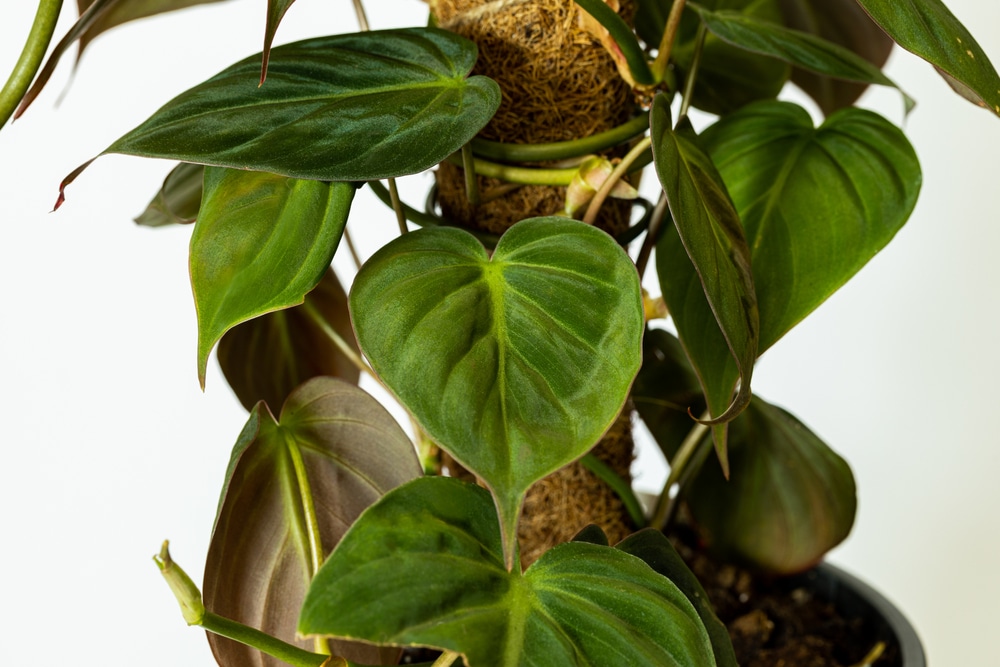
The philodendron micans has small green heart-shaped leaves with maroon-brown undersides. As its other common name suggests, the leaves have a unique soft velvety texture. Depending on the light, the leaves may appear deep green to rusty brown.
The leaves are smaller than other philodendrons but they make up for it in their coloring and texture. The velvety texture gives them an almost glowing quality.
It prefers bright light but can tolerate low light conditions. However, with less light, the leaves will be smaller and lose their maroon coloration.
Philodendron Micans can be grown in hanging baskets or in a pot on top of a bookcase to trail down. It can also be trained to grow upright on a vertical support like a trellis or moss pole.
| Origin | Central America |
| Plant size | 8 inches (20 cm) high, 24 inches (60 cm) long |
| Flowering | Rarely as a houseplant |
| Light | Bright indirect light. Tolerates low light |
| Watering | Allow top 2-3 inches (5 – 7.5 cm) of soil to dry out between waterings then water thoroughly |
| Fertilizer | Use balanced fertilizer, diluted by half, once a month during growing season. Stop fertilizing in winter |
| Potting soil | Peat-based potting blend with added perlite for improved drainage |
| Pruning | In spring, pinch back growing tips to encourage bushier growth |
| Repotting | Repot to slightly larger container when roots show through the drainage hole |
6 – Philodendron ‘Rio’ (Philodendron hederaceum ‘Rio’ sometimes found under Philodendron scandens)

Philodendron Rio is a rare sport (naturally-occurring genetic variation) of Philodendron hederaceum ‘Brasil’ that was originally discovered in a commercial greenhouse in Florida in 2009. It only recently became commercially available and so it can be hard to find.
Down the center of its leaves it has a unique variegated pattern of silver, cream and dark green stripes. The heart-shaped leaves are more elongated than its parent plant ‘Brasil’
‘Rio’ is a slow-grower so it won’t need frequent feeding or repotting.
| Origin | Sport of Philodendron hederaceum ‘Brasil’ discovered growing commercially in Florida |
| Plant size | 3-4 feet (90 – 120 cm) long |
| Flowering | Rarely as a houseplant |
| Light | Bright indirect light. Not low-light tolerant |
| Watering | Allow top 2-3 inches (5 – 7.5 cm) of soil to dry out between waterings, then water deeply |
| Fertilizer | Apply an all-purpose liquid fertilizer diluted by half every 6 weeks during the growing season |
| Potting soil | Peat-based potting blend with added perlite for improved drainage |
| Pruning | Prune to control size and encourage bushier growth |
| Repotting | Repot when roots are showing in the drainage holes |
7 – Silver Sword Philodendron (Philodendron hastatum)
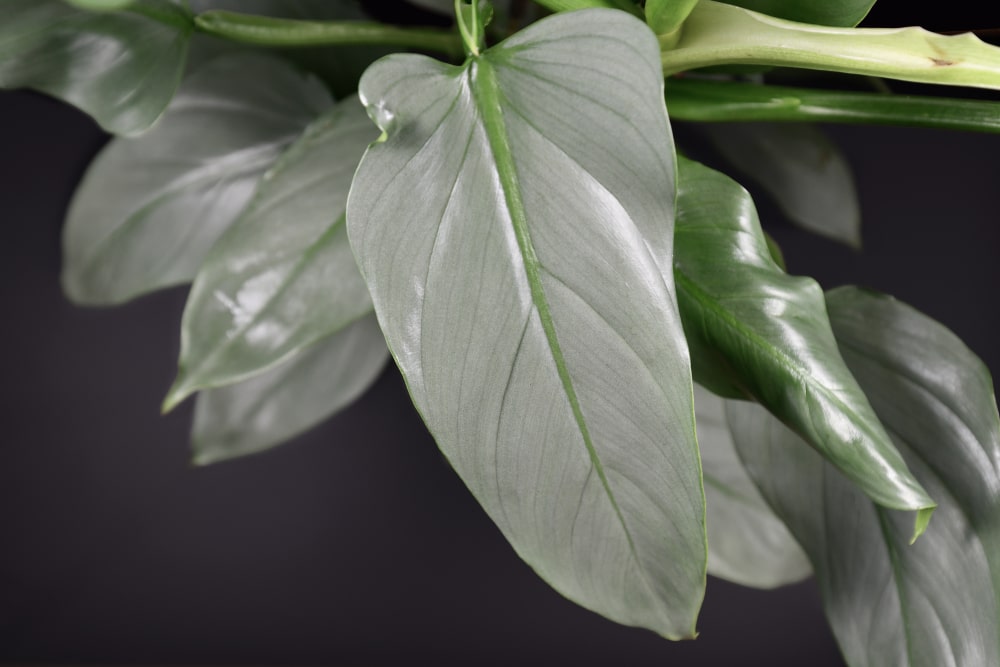
Silver Sword is a unique philodendron with pale grey-green foliage with a metallic hue that gives the plant a luminous ghostly appearance. The leaves are long and lance-shaped, and on a mature plant can grow up to 9 inches (22.5 cm) wide and two feet (60 cm) long. Its Latin name comes from an ancient spear-type weapon called a “hasta” used by the Romans.
It is an easy-care plant that can be grown as a trailer in hanging baskets or on top of a bookcase. It can also make a stunning specimen with more vigorous growth when trained to grow vertically on a trellis or moss pole.
As a houseplant, Silver Sword’s size will depend on how much room it is given to grow into. If given large enough supports, the vines can grow more than 10 feet (3 m) tall. Regular pruning will control its height and encourage bushier growth.
| Origin | Brazil |
| Plant size | 10-15 feet (3 – 4.5 m) tall and 2 feet (60 cm) wide |
| Flowering | Rarely as a houseplant |
| Light | Bright indirect light |
| Watering | Regular even moisture. Water when top 2 inches (5 cm) of soil is dry |
| Fertilizer | Apply balanced liquid fertilizer once a month during growing season |
| Potting soil | Peat-based with added perlite for good drainage |
| Pruning | Prune to control height and encourage denser growth |
| Repotting | Every 2-3 years |
Upright Philodendrons
8 – Blushing Philodendron (Philodendron erubescens)
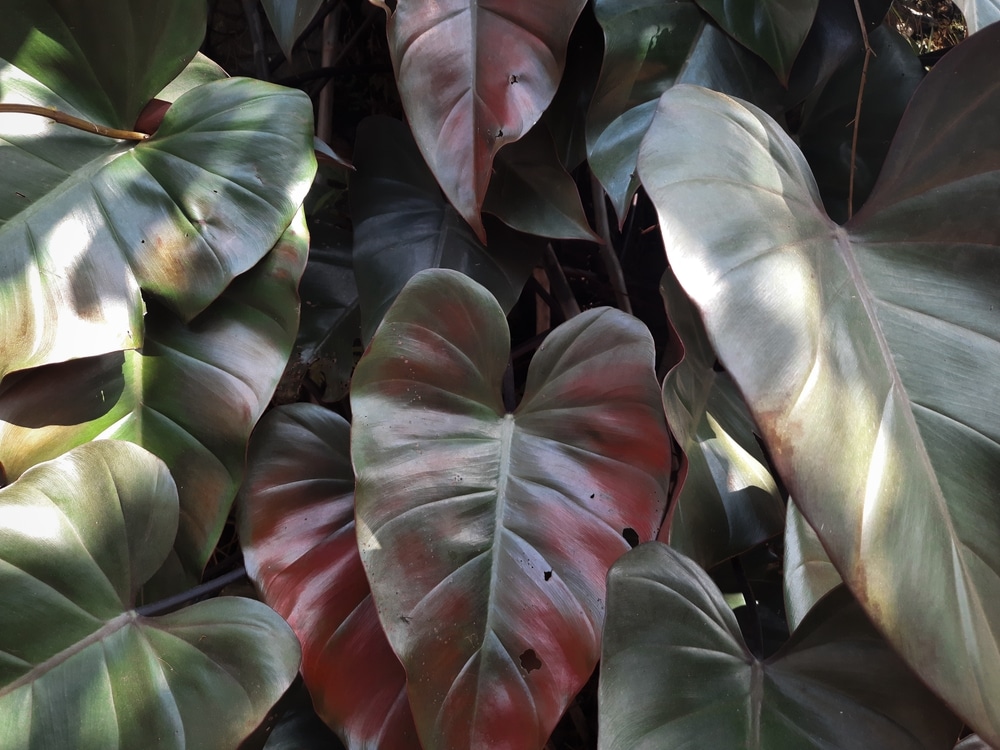
Blushing philodendron is one of the upright varieties that likes to climb. It has glossy elongated heart-shaped leaves with long wine-red petioles (leaf stems). The leaves are thick and leathery, and reach up to 10 inches long. They emerge with a reddish tinge, and turn to dark green with wine-red edges and undersides as they mature.
There are several hybrids of P. erubescens with different colored foliage. Some of the more interesting ones include:
- ‘Red emerald’ The young leaves emerge red and gradually turn green and velvety, with wine-red stems.
- ‘Green emerald’ This hybrid sports rich glossy green spear-shaped leaves.
- ‘Black cardinal’ This dramatic variety has glossy leaves that emerge burgundy red, then gradually turn to dark green then a dark purple-green almost black as they mature.
- ‘Pink Princess’ This is a very rare variety sought-after for its dark green leaves with bright bubblegum pink variegation
| Origin | South America |
| Plant size | Several feet long |
| Flowering | Rarely as a houseplant |
| Light | Bright indirect light |
| Watering | Water thoroughly when top inch (2.5 cm) of soil is dry. Can tolerate occasional short periods of drought |
| Fertilizer | Apply balanced liquid fertilizer once a month during growing season |
| Potting soil | All-purpose potting mix with added perlite for better drainage |
| Pruning | Pinch growing tips to encourage bushier growth |
| Repotting | In spring, repot into slightly larger container |
9 – Birkin Philodendron (Philodendron erubescens ‘Birkin‘)
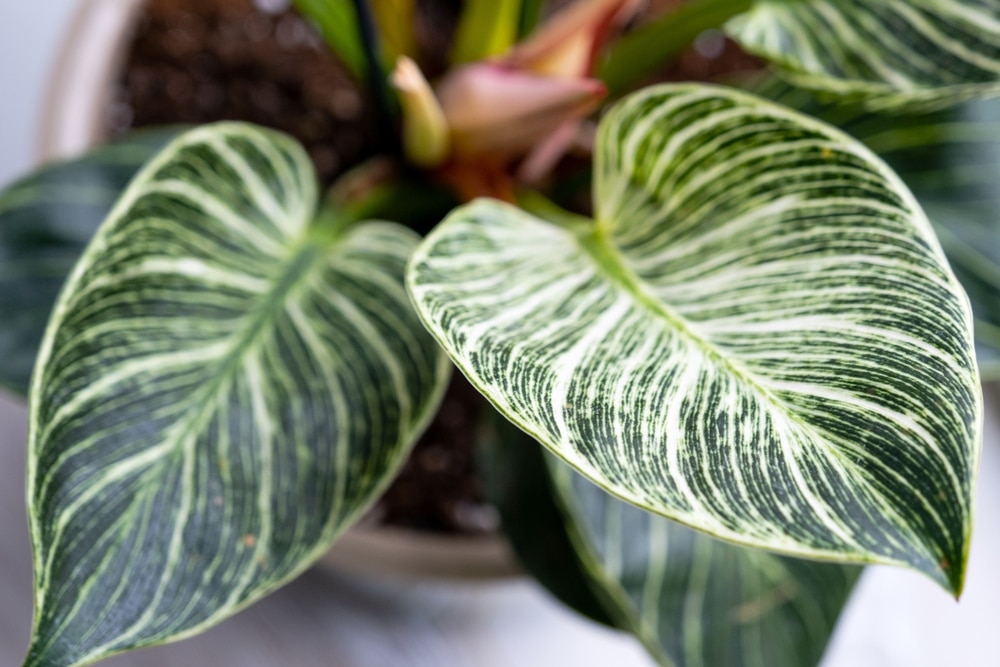
The Birkin Philodendron is a compact upright variety that doesn’t climb. It has ovate-shaped (tear-drops without a pointy tip) leaves with striking creamy-white stripes.
It’s named after fashion icon Jane Birkin, so you know it’s going to look fantastic wherever you choose to display it!
| Origin | Central America |
| Plant size | 12-24 inches (30-60 cm) tall and wide |
| Flowering | Rarely as a houseplant |
| Light | Bright indirect light. Can tolerate low light |
| Watering | Allow top 2 inches (5 cm) of soil to dry between waterings then water deeply |
| Fertilizer | Apply balanced liquid fertilizer diluted to half strength every 4-6 weeks during the growing season. Don’t fertilize in winter |
| Potting soil | All-purpose potting soil with added perlite for better drainage |
| Pruning | None needed. Cut off dead or damaged leaves |
| Repotting | Repot to slightly larger container when roots show through the drainage hole |
10 – Billietiae Philodendron (Philodendron billietiae)
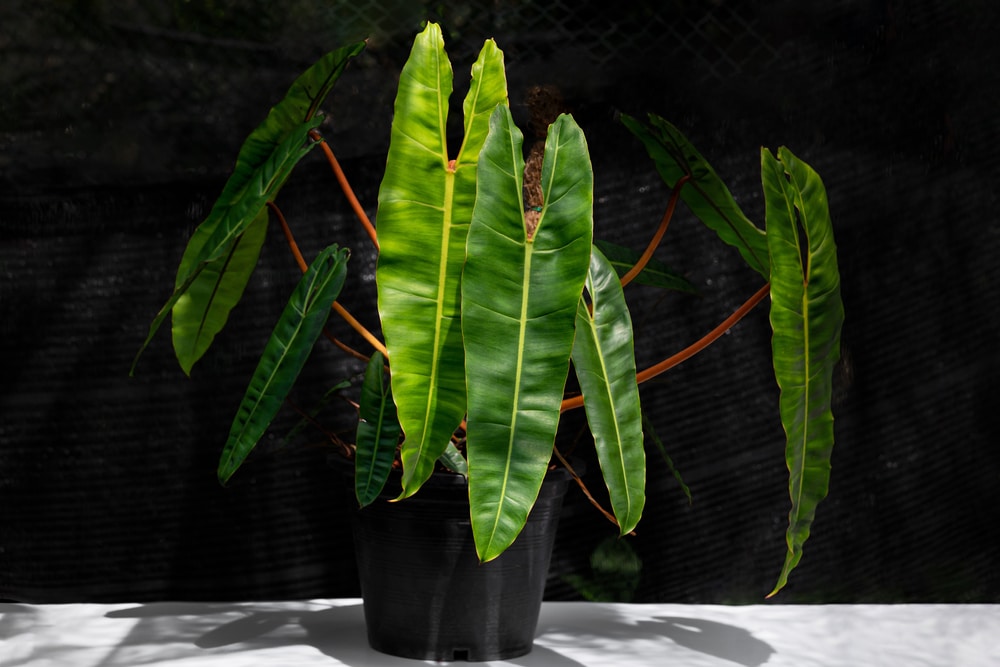
The Billietiae philodendron has elongated spade-shaped leaves with a wavy texture, supported on long orange-red petioles (leaf stems). The leaf shape brings to mind the silhouette of a fox’s head, with two pointy ears and a long narrow face!
It is a newer addition to the world of houseplants. It was discovered in its native habitat in the early 1980’s and came to the houseplant market in the mid 1990’s.
Billietiae is an upright variety that likes to climb. Be sure to secure it to a stake or trellis, or provide it with a moss pole so it can climb. Its narrow size makes it a good choice for small spaces.
| Origin | South America |
| Plant size | 3 feet (90 cm) tall and 8 inches (20 cm) wide |
| Flowering | Rarely as a houseplant |
| Light | Bright indirect light |
| Watering | Allow soil to dry between waterings then water deeply |
| Fertilizer | Apply balanced liquid fertilizer diluted to half strength every 4-6 weeks during the growing season. Don’t fertilize in winter |
| Potting soil | Indoor potting-mix with added perlite to improve drainage |
| Pruning | Remove dead leaves |
| Repotting | Every 2 years or when roots show through the drainage holes |
11 – McColley’s Finale Philodendron (Philodendron ‘McColley’s Finale’)
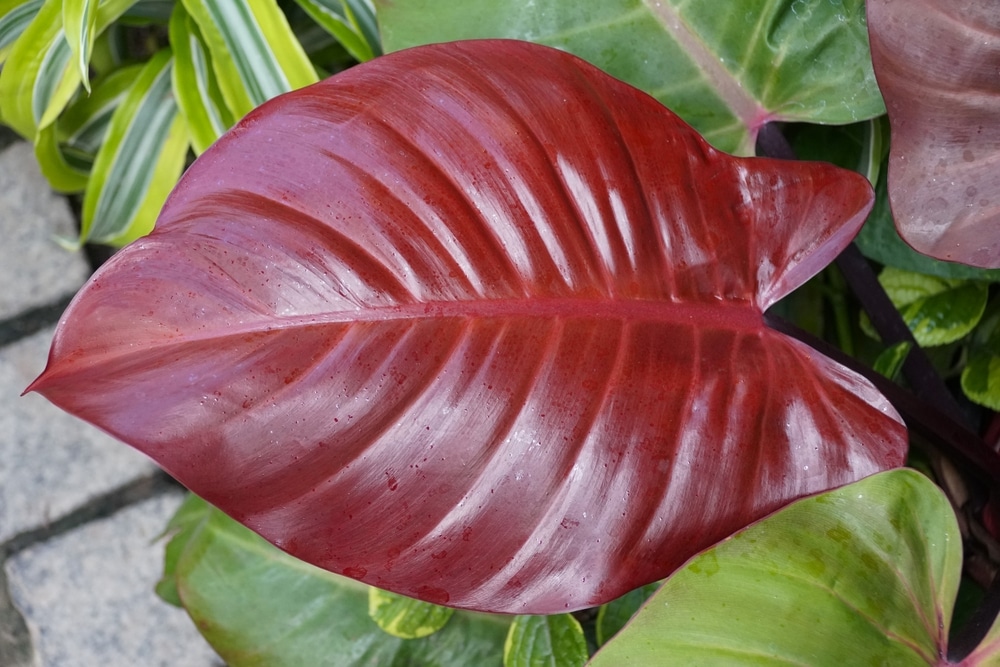
McColley’s Finale is a truly spectacular fast-growing selection. Its long oval leaves emerge a deep reddish-orange (like a cinnamon stick), transition to bronze and then finally to a deep glossy green. With all colors showing on the plant at one time, the effect is a visual knock out!
This particular hybrid is named after Robert H. McColley, the man who developed it at Florida State University.
| Origin | South America |
| Plant size | 3 feet (90 cm) tall |
| Flowering | Rarely as a houseplant |
| Light | Bright indirect light |
| Watering | Allow top 2 inches (5 cm) of soil to dry between waterings then water deeply |
| Fertilizer | Apply balanced liquid fertilizer diluted to half strength every 4-6 weeks during the growing season. Don’t fertilize in winter |
| Potting soil | Peat-based mix with added perlite for better drainage |
| Pruning | Cut off dead leaves |
| Repotting | Repot when roots are showing through drain holes |
12 – Oak-Leaf Philodendron (Philodendron pedatum)

The oak-leaf philodendron is an eye-catching upright climber with large dark green deeply-divided leaves (hence its name) growing from a thick trailing stem. The long leaf stems are a deep wine red and give nice contrast to the foliage.
The leaves grow about 6 inches (15 cm) apart along the stem and as the plant matures the leaves are larger when they grow in.
This philodendron makes a better climber tied to upright supports rather than left as a trailer. The leaves have long stems, giving the plant a more upright appearance. In addition, as the main stems mature, they become more woody, and if left to trail, they will break off. (If this happens, you can stick them in a jar of water to root and make a new plant!)
It’s a vigorous grower and is adaptable to varying growing conditions. It prefers bright indirect light. In lower light, it will grow more slowly and lose its attractive coloration.
This philodendron likes a lot of humidity. Mist the plant 2-3 times a week in summer. In winter, you may need to mist it more often, depending on how hot and dry the air is.
| Origin | Central America |
| Plant size | Up to 8 feet tall (2.5 m) |
| Flowering | Rarely as a houseplant |
| Light | Bright indirect light, tolerates low-light |
| Watering | Keep soil evenly moist. Allow soil surface to dry out between waterings during the growing season. In winter, allow ⅔ of the soil to dry out between waterings |
| Fertilizer | Apply diluted liquid fertilizer once a month during the growing season. Don’t fertilize in winter |
| Potting soil | Peat-based potting mix, with added perlite for good drainage |
| Pruning | Cut off dead leaves. In spring, cut back leggy specimens to just above a healthy leaf. |
| Repotting | In spring, when roots are growing out the drainage holes |
13 – Cutleaf Philodendron (Philodendron ‘Xanadu’)
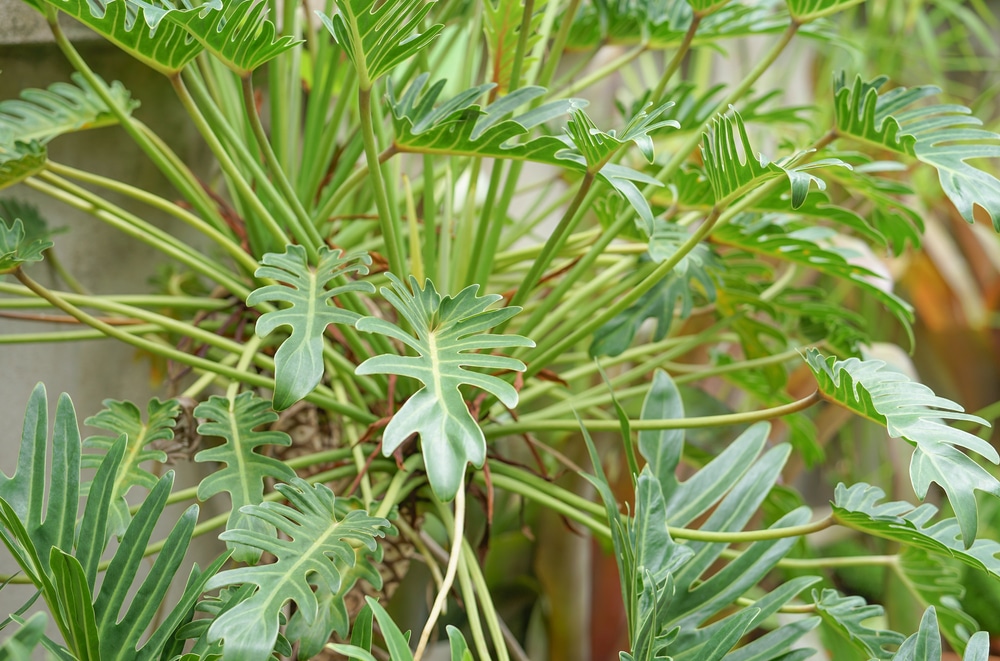
Xanadu is a compact upright-growing philodendron with a dense habit. It has deeply cut dark green glossy leaves that are held singly on tall stems growing in a clump from a central base. The leaves themselves can grow to be 16 inches (40 cm) long. It is a moderately fast grower.
To keep it looking its best, wipe the leaves with a damp cloth every few months.
| Origin | Brazil |
| Plant size | 3-5 feet (90 – 150 cm) tall and wide |
| Flowering | Rarely as a houseplant |
| Light | Bright indirect sun |
| Watering | Allow top inch (2.5 cm) of soil to dry out between waterings. Water deeply. |
| Fertilizer | Fertilize once a month during the growing season with balanced liquid fertilizer. Don’t fertilize in winter |
| Potting soil | Well-draining |
| Pruning | None needed. Cut off dead or damaged leaves |
| Repotting | Every 2-3 years or when plant becomes pot-bound |
14 – Burle Marx Philodendron (Philodendron burle-marxii)
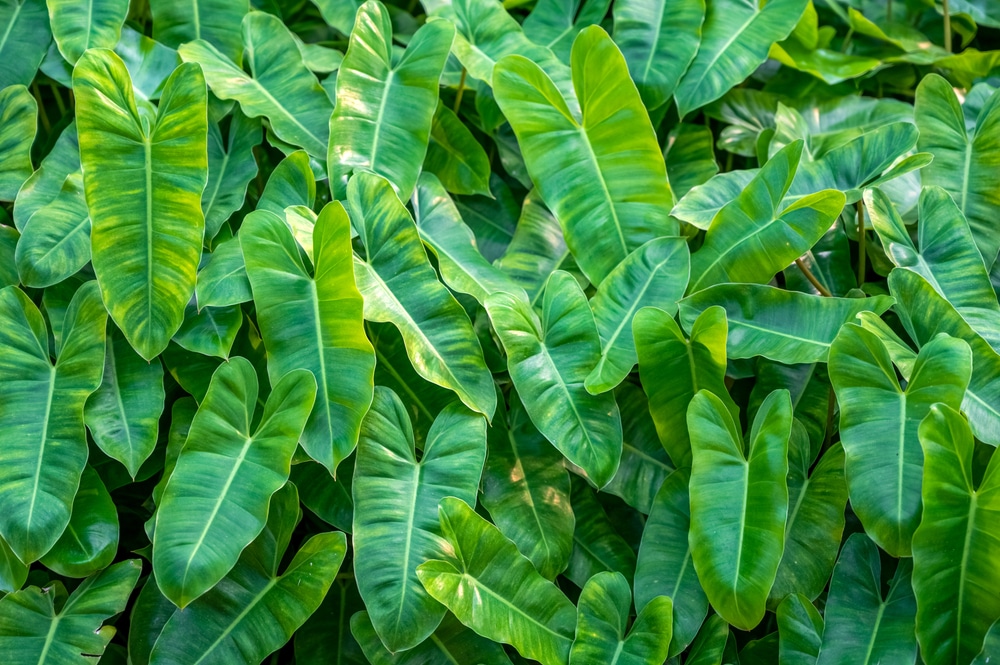
The Burle Marx philodendron is a fast-growing bushy climber with medium-sized lance-shaped leaves.
Its larger leaves and bushy climbing habit make it a great candidate for a moss pole or other vertical supports.
The plant is named after the famous Brazilian landscape architect, Roberto Burle Marx who replaced the formal European-style gardens with his native country’s own rich tropical flora. He introduced the use of tropical plants to gardens and buildings through his commissions worldwide.
| Origin | Brazil |
| Plant size | 2-3 feet (60-90 cm) tall and wide |
| Flowering | Rarely as a houseplant |
| Light | Bright indirect light |
| Watering | Allow top 1-2 inches (2.5 – 5 cm) of soil to dry between waterings. Water deeply during growing season. Reduce watering in winter |
| Fertilizer | Apply balanced liquid houseplant fertilizer once a month during the growing season. Stop fertilizing in winter |
| Potting soil | All purpose potting mix with added perlite for good drainage |
| Pruning | In spring, prune to control height and shape. |
| Repotting | Once a year, in spring |
15 – Ecuador Philodendron (Philodendron verrucosum)
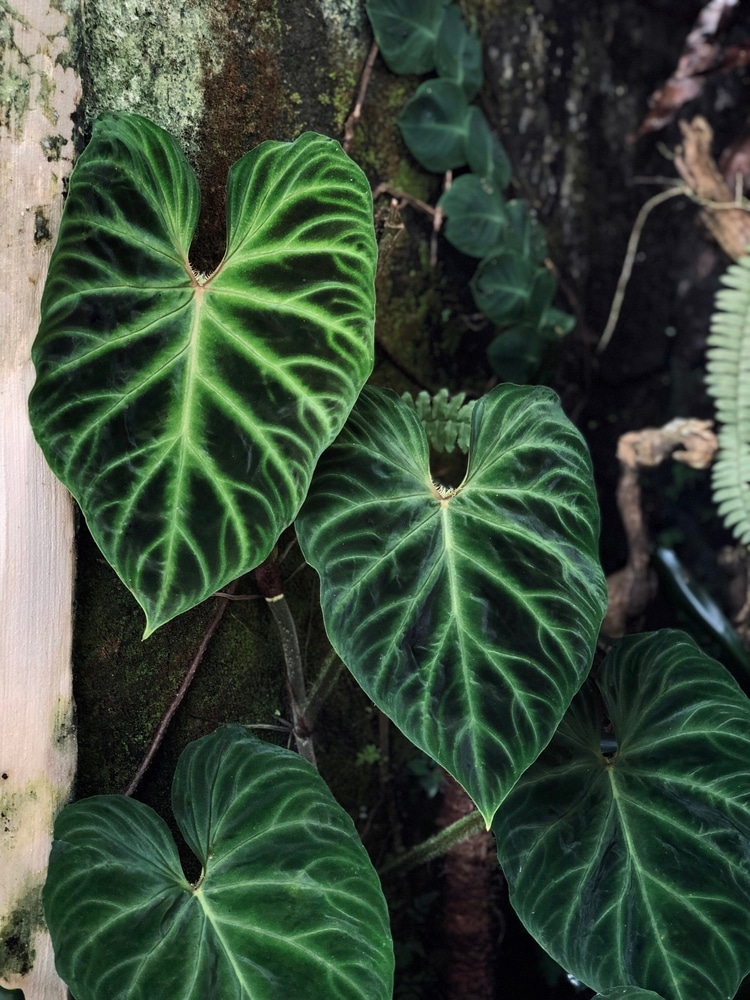
The Ecuador philodendron has large velvety heart-shaped leaves with distinct lighter-colored ribbing (veins). The leaves are purple-hued dark green on top, and dark wine red underneath. They are held on long hairy orange-tinged petioles (the stem-like portion that connects the leaf to the main stalk of the plant.) All in all, quite the tropical eye-candy!
Where it differs from other philodendrons is in its higher maintenance needs. It’s a little fussier than most. Given the right conditions, though, it will grow well and quickly add a bit of the jungle to the corner of a room.
This is another one of the climbers that will definitely need a strong support like a moss pole or trellis to train its growth and hold up its large showy foliage. It can also be pruned to maintain a lower bushier habit. Like many philodendrons, it also grows long aerial roots.
| Origin | South America |
| Plant size | 3 feet (90 cm) tall and 2 feet (60 cm) wide |
| Flowering | Rarely as a houseplant |
| Light | Bright indirect light |
| Watering | Allow top inch (2.5 cm) of soil to dry out between waterings. Water deeply for even moisture but don’t overwater |
| Fertilizer | Apply balance liquid fertilizer diluted to half recommended strength every 4-6 weeks during the growing season. Don’t fertilize in winter |
| Potting soil | Well-draining soil. A blend of peat moss, perlite and orchid bark |
| Pruning | Cut off any dead, yellow or damaged leaves. Prune growth tips to encourage denser growth |
| Repotting | Every 2-3 years or when plant gets pot bound |
16 – Blotched Philodendron (Philodendron mamei)
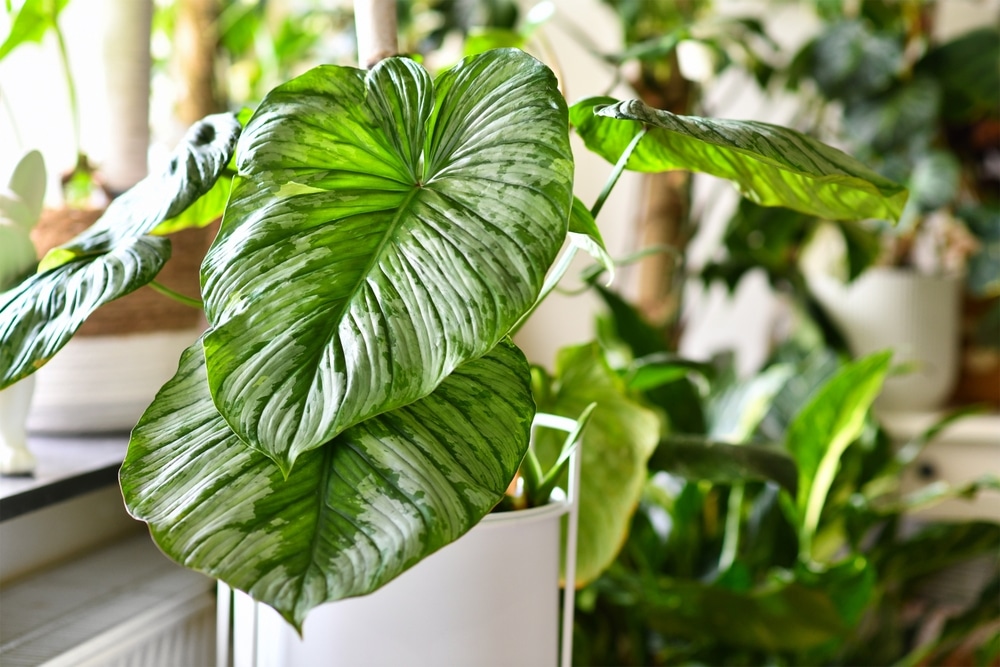
The Blotched philodendron is prettier than its name implies! It has large heart-shaped deep green leaves with silvery streaks of variegation. The leaves have deep veins, giving them an interesting visual texture.
This plant likes a lot of humidity. It’s a great choice for a large bright bathroom. Mist the plant regularly with a spray bottle or invest in a humidifier.
| Origin | South America |
| Plant size | Up to 3.5 feet (106 cm) tall |
| Flowering | Rarely as a houseplant |
| Light | Bright indirect light |
| Watering | Water deeply when top 2 inches (5 cm) of soil feels dry |
| Fertilizer | Not a heavy feeder. Apply a diluted water-soluble fertilizer once a month during the growing season |
| Potting soil | Well-draining peat-based mix with added perlite |
| Pruning | Cut off dead or damaged foliage. For shorter, bushier plant, cut back in spring |
| Repotting | Repot when roots start to grow from drainage holes |
17 – Tree Philodendron, Split-Leaf Philodendron (Thaumatophyllum bipinnatifidum formerly Phillodendron bipnnatifidum or P. selloum)
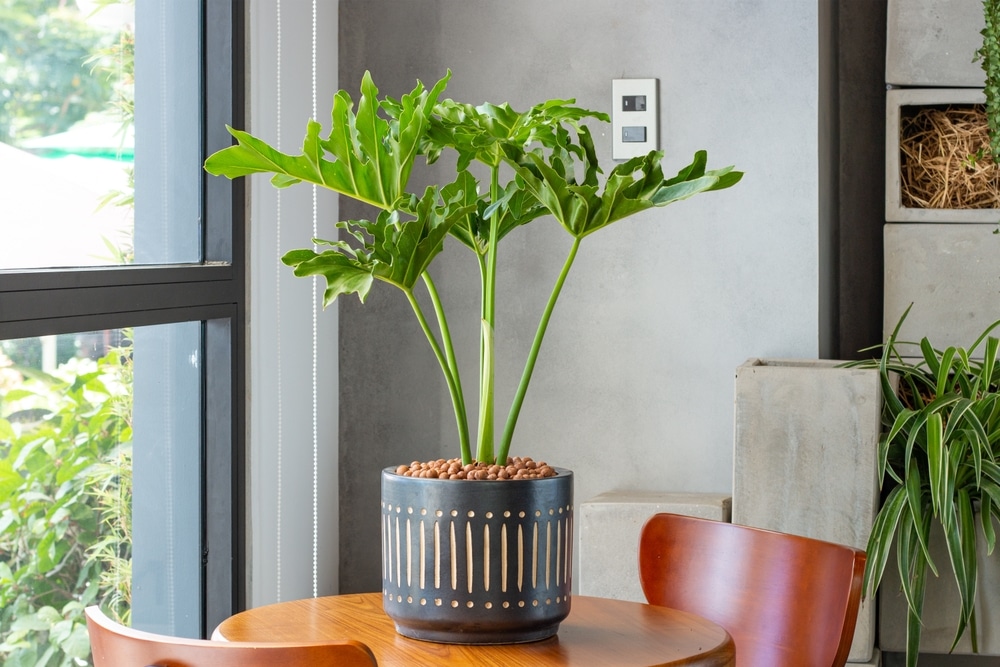
Note: This is the true split-leaf philodendron. A similar-looking plant, the swiss cheese plant (Monstera deliciosa) is sometimes incorrectly called a split-leaf philodendron.
The split-leaf philodendron doesn’t climb. As its other common name suggests, it is a sturdy spreading plant that eventually develops a thick tree trunk-like stalk. It forms an impressive tall architectural feature in large open-concept indoor spaces.
Young leaves are heart-shaped with indented edges. As the leaves mature, the indentations become more pronounced until the mature leaf – now long and arrow-shaped – has looks split into several smaller leaflets. Mature leaves grow up to 3 feet (90 cm) long. With such large glossy leaves, tree philodendrons will benefit from the occasional dusting with a damp cloth.
The leaves are carried on long stalks growing from around a central crown.
Unlike many philodendrons, this one doesn’t tolerate drought, and needs consistently moist – but not wet – soil.
| Origin | Brazil |
| Plant size | 4-6 feet (120 – 182 cm) tall and up to six feet (182 cm) wide |
| Flowering | Rarely as a houseplant |
| Light | Bright indirect sun |
| Watering | Keep soil evenly moist during the growing season.In winter reduce watering and allow soil surface to dry out between waterings |
| Fertilizer | Apply balanced liquid fertilizer every 2 weeks during the growing season |
| Potting soil | Soil-based mix with added peat moss |
| Pruning | Remove dead or yellowing leaves |
| Repotting | Every 2 years or when roots show through drainage holes |
Where To Buy
Philodendrons are a common houseplant sold in garden centers, florist’s shops, grocery, and big box stores.
You can also purchase them online. While it’s better to buy plants in person, online may be the only option when searching for rare and unusual varieties.
Tips On Buying Philodendrons
Look for leaves that are nice and green, no pale yellow patches or edges (unless the plant is supposed to be multi-coloured!) There should be no dead dry brown tips or spots on the leaves. Be sure the leaves aren’t soft and droopy-looking. Also look for healthy new growth coming in at the tips or base of the plant.
Look for very fine webbing on the underside of leaves and where the leaves attach to the stem (sign of spider mites). Check for things that look like small dabs of cotton wool on the underside of leaves or where the leaves attach to the main stem (sign of mealybugs).
FAQ
Do Philodendrons Flower?
Philodendrons rarely flower when grown as a houseplant. They won’t flower until the plant is over ten years old, and even then only if the growing conditions are just right.
Philodendrons are members of the Araceae or arum family. Arums have long narrow flowers called a “spadix” that grow up from a modified leaf (called a spathe) shaped like a cupped hand. Popular houseplants in the arum family that will flower indoors are Anthuriums and the Peace Lily.
Are Philodendrons Poisonous To Cats & Other Pets?
It’s important to note that all philodendron varieties are toxic to people and pets. They contain crystals of a compound called calcium oxalate that can cause swelling of the mouth, stomach irritation, and diarrhea. Philodendron sap can cause skin irritation or rashes. In pets calcium oxalate can also cause excessive salivation.
So be sure to place philodendrons well out of reach of curious little hands and mischievous cats.

